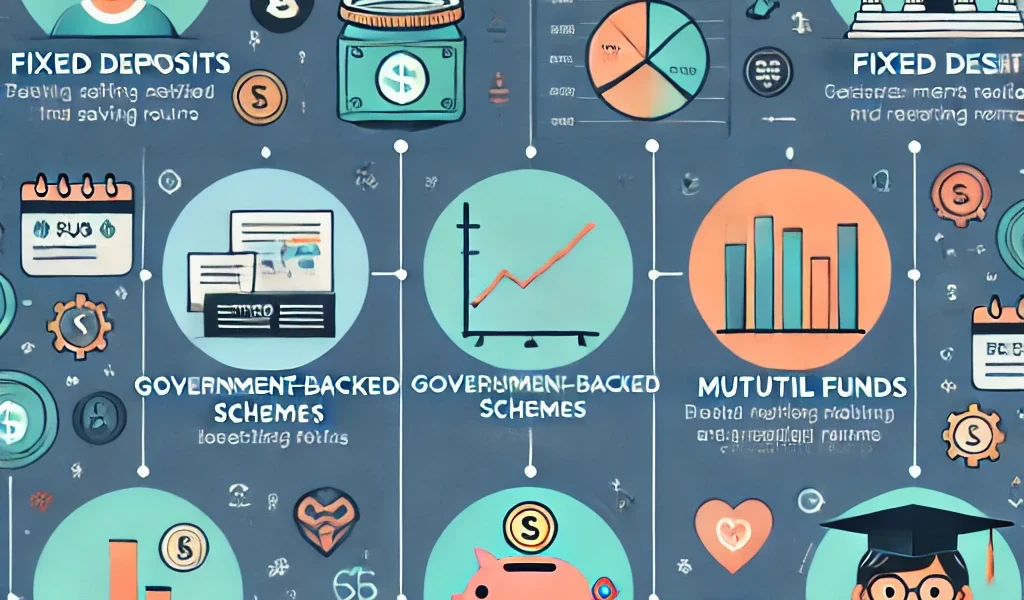Introduction
As parents, ensuring a secure financial future for your child is one of the most important responsibilities. Rising education costs, healthcare expenses, and unforeseen financial situations make it crucial to invest in children’s saving plans. These plans provide financial security, help build a strong corpus for education, and ensure your child’s future is well-planned.
This guide will cover the best children’s saving plans, key features to consider, and how to choose the most suitable option for your child’s needs.
Why Invest in a Children’s Saving Plan?
- Financial Security – Helps create a safety net for future expenses.
- Higher Education Planning – Covers tuition fees, study materials, and other academic costs.
- Medical Emergencies – Provides funds for any unexpected health concerns.
- Wealth Accumulation – Grows savings over time through interest and investments.
- Tax Benefits – Some plans offer tax exemptions under various sections of tax laws.
Types of Children’s Saving Plans
1. Child Savings Accounts
- Designed for minors with parental control.
- Offers competitive interest rates.
- Encourages financial discipline from an early age.
2. Fixed Deposits for Children
- Guaranteed returns with fixed interest rates.
- Lock-in period ensures disciplined savings.
- Safe investment option with no market risk.
3. Government-Backed Schemes
- Sukanya Samriddhi Yojana (SSY) (For girl children)
- Public Provident Fund (PPF) (Long-term savings with tax benefits)
- National Savings Certificate (NSC) (Safe investment with guaranteed returns)
4. Child ULIP Plans (Unit Linked Insurance Plans)
- Combines insurance and investment.
- Market-linked returns with flexible fund options.
- Tax benefits available under tax laws.
5. Education Insurance Plans
- Covers tuition fees and other educational expenses.
- Lump sum payout at maturity.
- Premium waiver benefit in case of the parent’s demise.
6. Mutual Funds and SIPs for Children
- Systematic Investment Plan (SIP) allows small investments over time.
- Higher returns with market-linked benefits.
- Flexible withdrawal options for education or emergencies.
7. Gold Investments
- Physical gold, gold ETFs, or sovereign gold bonds.
- Hedge against inflation.
- Can be used for future education or marriage expenses.
How to Choose the Best Children’s Saving Plan?
1. Define Your Financial Goal
- Are you saving for higher education, marriage, or general financial security?
- Determine the required amount and time frame.
2. Risk Appetite and Investment Horizon
- Low-Risk: Fixed deposits, PPF, Sukanya Samriddhi Yojana.
- Medium-Risk: Child insurance plans, balanced mutual funds.
- High-Risk: Equity mutual funds, ULIPs.
3. Tax Benefits
- Check for tax exemptions under Section 80C, 10(10D), or similar applicable laws.
- Plans like PPF, Sukanya Samriddhi, and life insurance policies offer tax savings.
4. Flexibility and Liquidity
- Choose a plan that allows partial withdrawals or premature closure in case of emergencies.
- Avoid locking funds in schemes with rigid terms unless necessary.
5. Inflation-Adjusted Returns
- Opt for investment plans that outperform inflation, ensuring real growth of savings.
Comparison of Popular Children’s Saving Plans
| Saving Plan | Risk Level | Returns | Lock-in Period | Tax Benefits |
|---|---|---|---|---|
| Child Savings Account | Low | 3-5% | No | No |
| Fixed Deposit (FD) | Low | 5-7% | Varies | No |
| Sukanya Samriddhi Yojana | Low | 7-8% | Until 21 years of age | Yes |
| PPF | Low | 7-8% | 15 years | Yes |
| Child ULIP | Medium | Market-linked | 5+ years | Yes |
| Mutual Funds (SIP) | High | 10-15% | No | No |
| Gold Investment | Medium | Market-linked | No | No |
Best Practices for Growing Your Child’s Savings
✅ Start Early: The earlier you start, the more you can accumulate through compounding. ✅ Diversify Investments: Mix fixed-income and market-linked investments. ✅ Automate Savings: Set up auto-debit for systematic savings. ✅ Review Periodically: Adjust investments based on financial goals and market conditions. ✅ Use Windfalls Wisely: Allocate bonuses or tax refunds to your child’s fund.
Common Mistakes to Avoid
❌ Not Planning Early Enough – Delaying savings can reduce the benefits of compounding. ❌ Ignoring Inflation – Ensure your savings beat inflation over time. ❌ Withdrawing Prematurely – Keep funds secure until necessary. ❌ Not Considering Tax Implications – Choose tax-efficient investments. ❌ Relying Solely on One Option – Diversify for better financial security.
Conclusion
A well-structured children’s saving plan ensures a bright and secure future. Whether you choose government-backed schemes, fixed deposits, mutual funds, or child insurance plans, each option serves a specific purpose. The key is to start early, invest wisely, and review periodically to align with changing financial needs.
💡 Begin today and secure your child’s dreams with the right saving plan! 🚀




